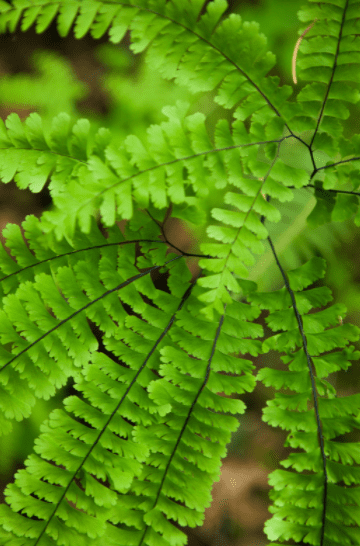Maidenhair Fern
Many ferns thrive in captivating patterns and remote places. Still, maidenhair fern wins the contest with its silky purplish-black stems, almost spiraling frond structure, and extraordinary capability to colonize on a rock precipice under a waterfall.
Most Adiantum species, appearing at low and mid altitudes throughout the Pacific Northwest, require a continuous nearby water source to survive.
Like most ferns, maidenhairs propagate by spores produced on the edges of their fragile wedge-shaped leaflets.
The deciduous ferns usually grow one or two feet tall, producing five to seven finger-like branchlets, each with many leaflets fanning out—the branchlets fork and spread out of both sides of the central stem in a one-way radial pattern.
Maidenhair Ferns Regions
Maidenhair ferns are most often found in moderately shaded woodlands or alongside seeps, springs, and forest streams in well-drained, humus-rich soils. However, some maidenhair ferns can grow in the open sunlight at or near sea level. And one variety seems to prefer serpentine or limestone soils for habitat.
The uniquely colored and shaped ferns range from the banks of the Rogue River in southern Oregon to the southern United States, the Andes in South America, and wetter parts of Europe, Asia, and New Zealand.

The perennial plant is a favorite in native gardens with ponds or other consistent moisture. But just like the trickles it often neighbors, the maidenhair fern can be temporary and tough to sustain over the years.
Maidenhair ferns are also meticulously collected and used by indigenous people in basket weaving.
They have reported some medicinal purposes for the plant, although the lore on this subject seems to vary wildly. In Europe, maidenhair fern tea, syrup, or tincture has been rumored to cure ailments from hair loss to coughs, though there’s little evidence that the plant worked as an antidote to baldness.
It can, however, turn your existing hair yellow, according to some origins.
Maidenhair Fern Growing Indoors And Outdoors
These delicate foliage plants have decorated more homes than most alternative plants. Even though, for many, it is a challenging plant to grow and care for. The reason for this is usually our thoughts on what conditions ferns like.
They thrive in obscured, humid areas, but when we take them indoors, the foliage usually browns off, and, after a time, we have a dry arrangement, no matter how much water we give them.
The bathroom turns up to be a good place for your maidenhair fern, with plenty of moisture and dappled light. Many bathrooms face towards the south, and having an opaque window means that the amount of reflected light for growing ferns is often not enough.
This state can vary during the year as a fern may do well through the long days of the summer months but, as the light hours shorten, the fern will commence to brown off.
Maidenhair Ferns Care
Maidenhair ferns grown indoors demand excellent light and even a certain amount of direct sunlight as the sun crosses a window. The best position is usually found within a meter of a bright, light window, exclusively for morning or late afternoon.
If the light is insufficient, the first indication of problems is that the new fronds will wither up too soon instead of opening and exposing their foliage.
Too dry a pot can also cause this to happen. The next event is that the older, mature fronds turn brown, and the whole fern could soon dry up. They can be saved by cutting off all the damaged foliage — sometimes, a haircut of all vegetation is needed.
Ensure the plant is moist, then place outdoors in a shaded area.
Outdoors maidenhair ferns thrive because they get plenty of light from all around, whereas indoors, they usually have natural light only from a window or doorway and rarely from overhead.
To be successful in growing maidenhair ferns indoors, make sure they are getting sufficient light all year round. Often, this can mean moving them closer to the window in the wintertime.
Typical Pests
Hardly a couple of typical insects notice indoor maidenhair ferns savory. Scale and mealybugs like to hook up themselves to the fronds. Look at the plant continually and deal with any contagion with insecticidal soap.
Typical Issues With Maidenhair Ferns
The young leaves of maidenhair ferns are susceptible. You’ll require to identify the appropriate indoor spot for the plant, or the leaves will let you learn it’s not located well.
If the air is dehydrated and the plant requires more moisture and humidity, the leaves will do: curl up, dry out at the tips and brown at the information, and drop off.
Cautious elimination of curled, dried-out, or browned leaves can help the fern flourish denser foliage.























